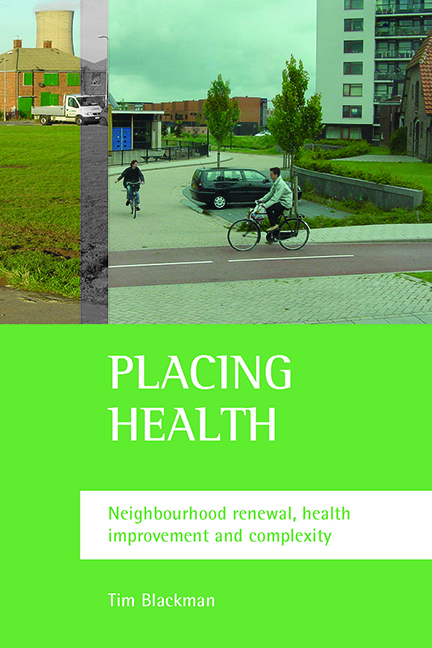Book contents
- Frontmatter
- Dedication
- Contents
- List of tables and figures
- Acknowledgements
- List of abbreviations
- Preface
- one Policy and places
- two Health, neighbourhoods and complexity
- three Emergence and environment press
- four The neighbourhood effect
- five Neighbourhood renewal and health inequalities
- six Health inequality as a policy priority
- seven Conclusion: neighbourhoods in the wider picture
- References
- Index
- Also available from The Policy Press
two - Health, neighbourhoods and complexity
Published online by Cambridge University Press: 18 January 2022
- Frontmatter
- Dedication
- Contents
- List of tables and figures
- Acknowledgements
- List of abbreviations
- Preface
- one Policy and places
- two Health, neighbourhoods and complexity
- three Emergence and environment press
- four The neighbourhood effect
- five Neighbourhood renewal and health inequalities
- six Health inequality as a policy priority
- seven Conclusion: neighbourhoods in the wider picture
- References
- Index
- Also available from The Policy Press
Summary
An introduction to complexity theory
This book argues that improving health in neighbourhoods can be informed by using complexity theory. The reason is that neighbourhoods and their ‘states’ are outcomes of complex causation.
A relationship whereby A causes B in a linear and mechanical fashion is simple (echoing the last chapter's point about ‘tame’ problems). Many such relationships operating together is complicated. Complexity arises when there is interaction between many elements, such as the relationship between A and B depending on interactions with C, D or E (a ‘wicked issue’ in policy terms). When this happens, emergent and difficult-to-predict properties can arise from the interactions.
While traditional quantitative research in the social sciences is concerned with analysing relationships between variables, such as the relationship between income inequality and rates of premature mortality, complexity theory focuses on cases as empirical and actual domains. The interest is in the ‘states’ of these cases; not so much how and why variables change but how and why cases change. There is a direct concern with context in this respect, which variables-oriented quantitative research tends to regard as a difficulty to be controlled for, rather than part of explanations. The nature of cases as configurations of compositional and contextual attributes that combine to produce emergent outcomes can be described and investigated in either qualitative or quantitative terms (Byrne, 2002).
Cases, whether individuals, households, neighbourhoods, organisations or economies, are conceptualised within this theoretical framework as complex adaptive systems with self-organising behaviour. They are open to their environment and therefore affected by it, and have characteristics that are often fuzzy, not least their boundaries. Fuzzy in this context means that cases are not necessarily crisply defined in terms of having or not having key attributes (key attributes being those that are causally linked with outcomes of interest). A case may be in one attribute category say 80% and in another say 30% (Ragin, 2000). Examples of neighbourhood attributes in this respect could be segregated/mixed, safe/unsafe or green/barren. The important thing about the extent of ‘in or outness’ is its causal significance in terms of changes in state.
- Type
- Chapter
- Information
- Placing HealthNeighbourhood Renewal, Health Improvement and Complexity, pp. 31 - 54Publisher: Bristol University PressPrint publication year: 2006



